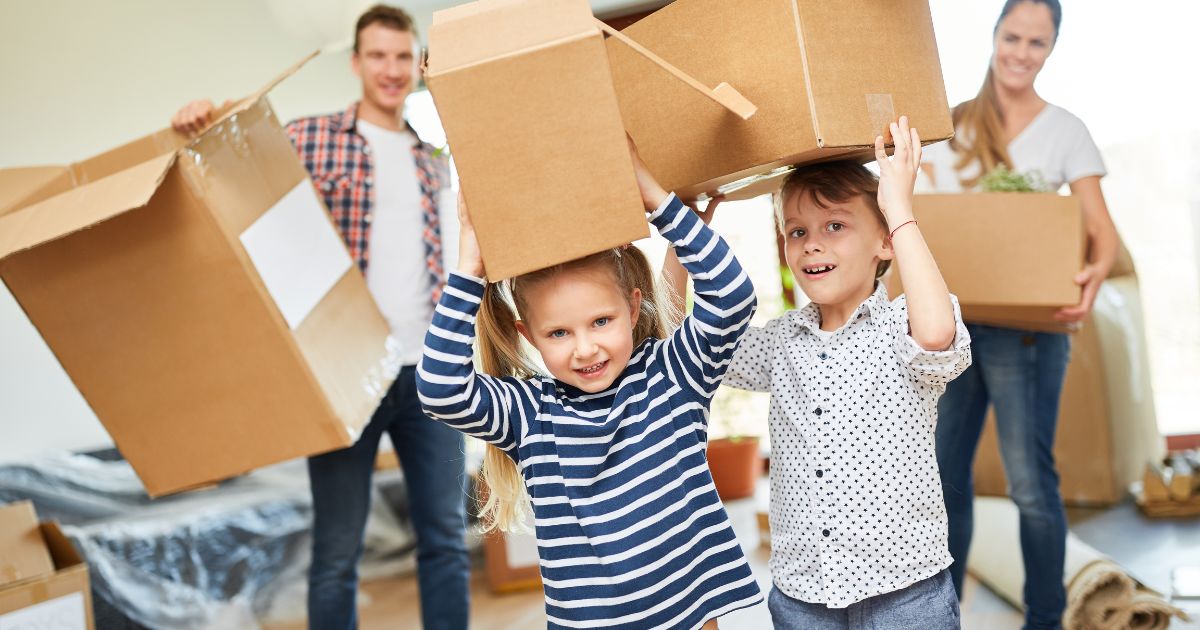
Moving homes ranks among life’s most stressful experiences—right up there with divorce and starting a new job. Now, throw children into the mix, and you’ve got a recipe for potential chaos. Last week, I watched my neighbor’s moving day unfold into a perfect storm of tears, tantrums, and frazzled parents desperately trying to keep track of both boxes and children simultaneously.
But here’s the thing—relocating doesn’t have to become the family nightmare many parents dread. With thoughtful planning and the right approach, moving can transform into an adventure that brings your family closer together. Children, despite their initial resistance, possess remarkable adaptability when they feel included and valued in the process.
That’s exactly why we’ve created this guide—to help families develop a kid-friendly moving plan that acknowledges your children’s emotions while making them active participants in your family’s next chapter. By following these practical strategies, you’ll not only make moving day smoother but potentially create positive memories along the way.
Why a Kid-Friendly Moving Plan Matters
Children experience moving differently than adults. While we focus on logistics and paperwork, kids face an emotional earthquake—their entire world shifts beneath their feet. Familiar bedrooms transform into empty spaces. Best friends become pen pals. Schools, playgrounds, and favorite ice cream shops vanish from their daily lives.
These changes hit hard. Research shows children often experience anxiety, sadness, and even regression during moves. Younger kids might suddenly need nightlights again, while teenagers retreat into silence or exhibit uncharacteristic behavior.
But here’s where smart parents gain the upper hand: involving children transforms them from passive passengers to active crew members on your family’s journey. When kids pack their special toys, help label boxes, or choose paint colors for their new bedroom, they gain precious control amid change. They process the transition through hands-on participation rather than just experiencing it happening to them.
The payoff extends beyond moving day itself. Families who navigate this transition together often emerge with strengthened bonds and children who’ve built valuable resilience skills.
Practical Strategies for a Kid-Friendly Move
Before the Move: Planting Seeds of Excitement
Open Communication Creates Safety
The moment you know you’re moving, gather your little ones for a family meeting. Like ripping off a bandage, it’s better to address the change directly rather than letting children sense something’s happening behind closed doors. Kids are emotional barometers—they’ll pick up on your whispered conversations and midnight planning sessions.
Frame the move as an adventure you’ll tackle together. For younger children, picture books about moving (like “The Berenstain Bears’ Moving Day”) can normalize the experience. Tweens and teens might appreciate more mature discussions about the “why” behind your relocation—whether it’s a job opportunity, better schools, or being closer to family.
When questions bubble up—and they will, often repeatedly—answer them honestly. “I don’t know yet” is a perfectly acceptable response, followed by “but we’ll figure it out together.”
Transform Kids from Passengers to Co-Pilots
Children thrive when given agency. Even your preschooler can make meaningful contributions to the moving process. Here’s how:
- Let them sort their toys into “keep,” “donate,” and “maybe” piles (with gentle guidance)
- Create a special box for treasured items they’ll carry personally on moving day
- Hold a “room design party” where they sketch ideas for their new space
- If possible, take virtual tours of your new neighborhood or drive by the house
- Ask for their input on simple decisions: “Should we put your bookshelf against this wall or that one?”
For older kids, responsibility equals investment. Assign them meaningful tasks like researching local attractions in your new area (for example, families moving to Pittsburgh might research Frick Park or the Children’s Museum), photographing items before packing, or creating a digital home inventory. My clients who’ve given their teenagers moving-related responsibilities often report surprised delight at their children’s organizational abilities.
Create Memory Anchors Before Leaving
The emotional goodbye is just as important as the practical preparation. Help your children create closure through:
- A farewell tour of beloved spots—their favorite playground, the local library, or that ice cream shop where they always ordered mint chocolate chip
- A “see you later” gathering with neighborhood friends (consider a simple pizza party or backyard cookout)
- A memory-capturing project like a scrapbook or video montage of your current home
One family I worked with created “neighborhood treasure boxes” where each child collected small mementos—a pebble from the creek, a pressed flower from the park—physical reminders they could take to their new home.
During the Move: Turning Chaos into Adventure
Their Special Moving Day Tasks
Moving day arrives like a whirlwind, transforming your once-organized home into a maze of boxes and bubble wrap. In this controlled chaos, children without clear roles often feel adrift—and that’s when meltdowns happen.
Give each child a moving day “job title” with responsibilities matched to their age. Your five-year-old might become the “Box Inspector,” ensuring nothing important gets left behind in empty rooms. Your tween could serve as “Family Photographer,” documenting your last moments in the old house and first steps into the new one.
Create a “moving day backpack” for each child containing:
- A clipboard with simple checklists they can mark off
- Stickers for labeling their personal boxes
- A special stuffed animal or comfort item designated as “moving buddy”
- A small flashlight for exploring the new home’s nooks and crannies
One mom told me her daughter took her “Official Moving Helper” badge so seriously that she reminded the professional movers to be extra careful with the family’s fragile items!
Keeping Them Entertained When Minutes Feel Like Hours
Moving day stretches time in strange ways. Five minutes of boredom can feel like an eternity to a child waiting for their life to restart.
Pack a separate “boredom buster” bag containing:
- New coloring books and markers (novelty is key here)
- Favorite snacks that won’t create sticky messes
- Tablet loaded with movies (yes, screen time rules can bend on moving day)
- A few small toys they haven’t seen in a while
For long-distance moves, consider wrapping small dollar-store items as “travel presents” to be opened at different milestones of your journey. The anticipation becomes part of the adventure.
After the Move: Planting Roots in Your New Home
Settling In Together First
The boxes tower like cardboard skyscrapers in your new living room. Your instinct might be to tackle everything at once, but experienced parents know better. Children need anchors in this sea of change.
Make their bedrooms priority #1. Even if it means your kitchen remains in boxes for an extra day, getting your kids’ spaces functional creates an immediate sanctuary. Set up their beds with familiar bedding, place a few cherished toys in visible spots, and hang artwork they created for their old room. This familiar corner becomes their safe harbor while the rest of the house transforms around them.
Next, establish a simplified version of your family routines. That first-night pizza picnic on the living room floor could become a cherished memory years later. Morning pancakes, bedtime stories—these small constants remind children that while walls change, family bonds remain unshakable.
Keeping Old Connections Strong
Technology becomes your ally in maintaining friendships. Help younger children schedule video calls with former neighbors or classmates. Teenagers might need gentle reminders that texting old friends remains important even as they navigate new social waters.
Create a simple calendar marking when you’ll visit your former neighborhood or when old friends might visit. Having these connection points on the horizon reassures children that “goodbye” wasn’t forever.
Discovering Your New Neighborhood
Each new location unfolds like a treasure map for newcomer families, with unique gems waiting to be discovered.
Transform weekend explorations into family adventures:
- Hunt for the best neighborhood playgrounds (families in Pittsburgh, for instance, might explore Frick Park’s blue slide playground, famous among local kids)
- Sample local eateries to crown your family’s new favorite spots (every region has its specialties—like Pittsburgh’s unique sandwich shops)
- Visit local attractions that could become new family traditions
Neighborhood libraries often host children’s programs where kids can meet potential friends. Many schools offer summer playground programs—perfect for mid-year moves when making friends proves challenging.
Making Moving Easier for the Whole Family
When storms gather on the horizon, wise sailors don’t just weather them—they learn to navigate through them. The same holds true for family moves. By implementing a kid-friendly moving plan, you’ve transformed potential rough waters into a manageable journey where everyone feels valued and heard.
The emotional benefits ripple through your entire household. Children who participate in the moving process develop resilience and adaptability—skills that serve them throughout life. Parents report less resistance, fewer meltdowns, and more cooperation when the whole family works together. Most importantly, you’re teaching your children how to navigate change with grace—a lesson more valuable than any they’ll learn in classrooms.
Finding Your Balance
The truth? Even with perfect planning, moving day brings challenges. Kids get cranky. Boxes go missing. Plans change without warning.
This is where professional help creates breathing room. While skilled movers handle the heavy lifting and logistics, you’re free to focus on what matters most—supporting your children through this transition. Those precious moments helping your daughter arrange her bookshelf just so, or exploring the new backyard with your son, become possible when you’re not wrestling with a moving truck or disassembling furniture.
Your New Beginning
Family transitions write chapters in your shared story. Years from now, your children won’t remember every box packed or wall painted—they’ll remember how it felt to be part of something bigger than themselves. They’ll recall the night you camped out in the empty living room before the furniture arrived. They’ll treasure traditions transplanted from old home to new.
The journey doesn’t end on moving day. As your family settles into your new neighborhood, continue nurturing that sense of adventure and teamwork. Visit community events together. Introduce yourselves to neighbors. Plant a family tree in your new yard as a symbol of your fresh start. Whether you’re moving across town or to a new city like Pittsburgh, creating these moments of connection will help your entire family thrive in your new surroundings.
At Don Farr Moving & Storage, we’ve helped countless families through this transition. But the most successful moves always share one common element—families who face the change together, creating something beautiful from the challenge. Contact us today for more information!


